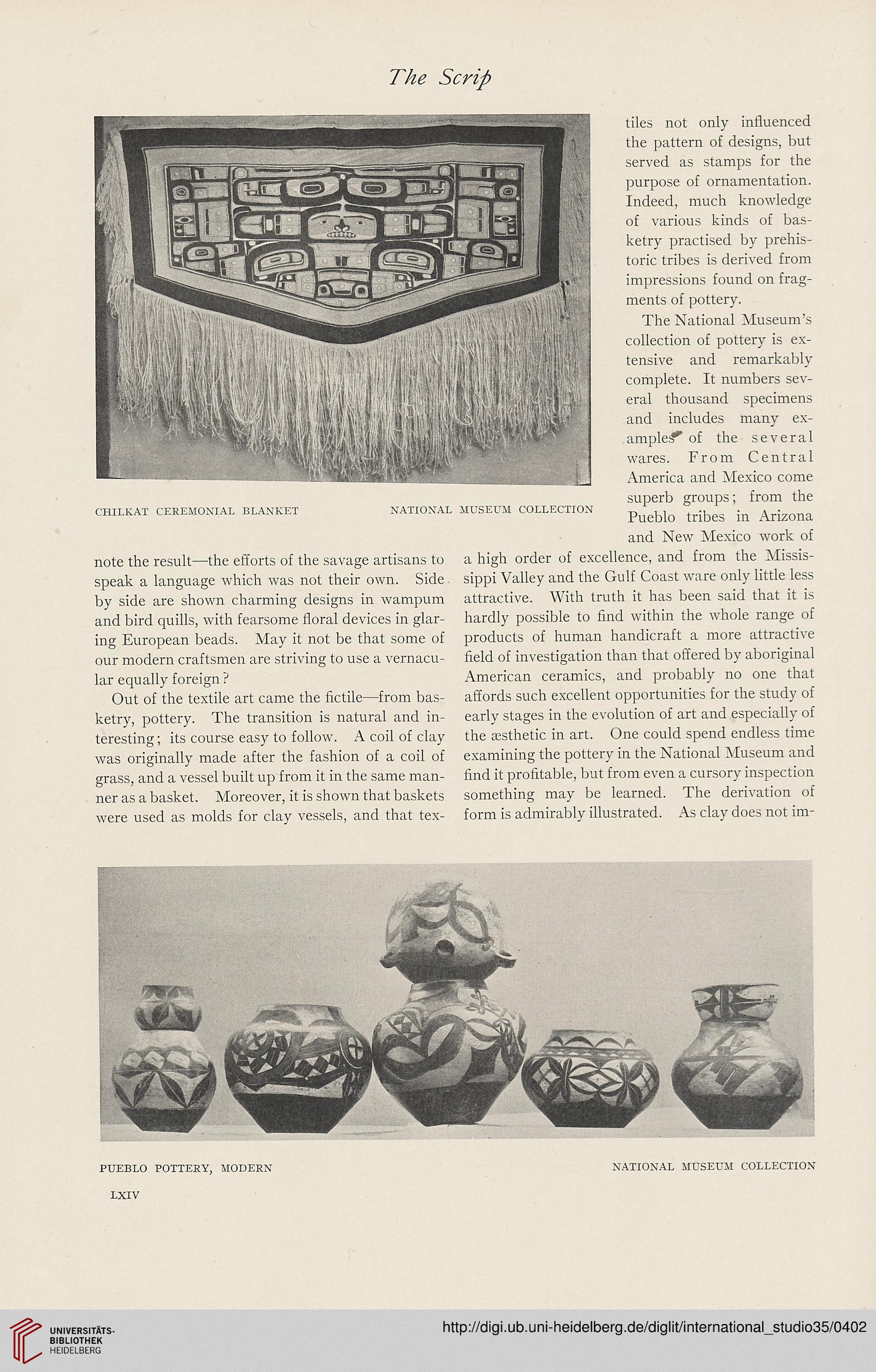The Scrip
note the result—the efforts of the savage artisans to
speak a language which was not their own. Side
by side are shown charming designs in wampum
and bird quills, with fearsome floral devices in glar-
ing European beads. May it not be that some of
our modern craftsmen are striving to use a vernacu-
lar equally foreign ?
Out of the textile art came the fictile—from bas-
ketry, pottery. The transition is natural and in-
teresting ; its course easy to follow. A coil of clay
was originally made after the fashion of a coil of
grass, and a vessel built up from it in the same man-
ner as a basket. Moreover, it is shown that baskets
were used as molds for clay vessels, and that tex-
tiles not only influenced
the pattern of designs, but
served as stamps for the
purpose of ornamentation.
Indeed, much knowledge
of various kinds of bas-
ketry practised by prehis-
toric tribes is derived from
impressions found on frag-
ments of pottery.
The National Museum’s
collection of pottery is ex-
tensive and remarkably
complete. It numbers sev-
eral thousand specimens
and includes many ex-
ample^ of the several
wares. From Central
America and Mexico come
superb groups; from the
Pueblo tribes in Arizona
and New Mexico work of
a high order of excellence, and from the Missis-
sippi Valley and the Gulf Coast ware only little less
attractive. With truth it has been said that it is
hardly possible to find within the whole range of
products of human handicraft a more attractive
field of investigation than that offered by aboriginal
American ceramics, and probably no one that
affords such excellent opportunities for the study of
early stages in the evolution of art and especially of
the aesthetic in art. One could spend endless time
examining the pottery in the National Museum and
find it profitable, but from even a cursory inspection
something may be learned. The derivation of
form is admirably illustrated. As clay does not im-
PUEBLO POTTERY, MODERN
NATIONAL MUSEUM COLLECTION
LXIV
note the result—the efforts of the savage artisans to
speak a language which was not their own. Side
by side are shown charming designs in wampum
and bird quills, with fearsome floral devices in glar-
ing European beads. May it not be that some of
our modern craftsmen are striving to use a vernacu-
lar equally foreign ?
Out of the textile art came the fictile—from bas-
ketry, pottery. The transition is natural and in-
teresting ; its course easy to follow. A coil of clay
was originally made after the fashion of a coil of
grass, and a vessel built up from it in the same man-
ner as a basket. Moreover, it is shown that baskets
were used as molds for clay vessels, and that tex-
tiles not only influenced
the pattern of designs, but
served as stamps for the
purpose of ornamentation.
Indeed, much knowledge
of various kinds of bas-
ketry practised by prehis-
toric tribes is derived from
impressions found on frag-
ments of pottery.
The National Museum’s
collection of pottery is ex-
tensive and remarkably
complete. It numbers sev-
eral thousand specimens
and includes many ex-
ample^ of the several
wares. From Central
America and Mexico come
superb groups; from the
Pueblo tribes in Arizona
and New Mexico work of
a high order of excellence, and from the Missis-
sippi Valley and the Gulf Coast ware only little less
attractive. With truth it has been said that it is
hardly possible to find within the whole range of
products of human handicraft a more attractive
field of investigation than that offered by aboriginal
American ceramics, and probably no one that
affords such excellent opportunities for the study of
early stages in the evolution of art and especially of
the aesthetic in art. One could spend endless time
examining the pottery in the National Museum and
find it profitable, but from even a cursory inspection
something may be learned. The derivation of
form is admirably illustrated. As clay does not im-
PUEBLO POTTERY, MODERN
NATIONAL MUSEUM COLLECTION
LXIV





